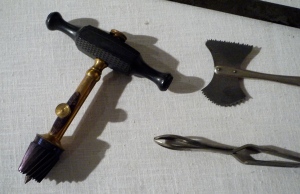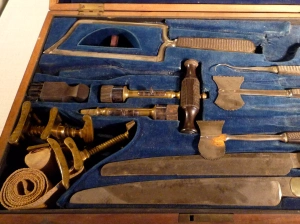The artifact collection at the Rose Melnick Medical Museum includes one amputation set and one surgical kit, both from the 19th century. Both kits contain tools for general surgical procedures of the time including tourniquets, knives and scalpels, capital saws, tenacula, and artery forceps. Both kits also include trephining tools for cutting the skull. Although by the 1860s the procedure was performed less often, it was still used to treat hemorrhages, sub-dural abscesses, and depressed fractures of the skull. The main trephine tool is the “T” shaped trepan with a bladed cylinder at one end. Other tools for trephining are the Hey’s saw (small saw with one rounded and one straight edge) and the elevator (a flat metal instrument with a small scoop used to lift small pieces of bone).
You can see a video of our surgical and amputation tools here.

The surgical kit pictured below dates from 1840 to 1888 and was made by Jacob H. Gemrig of Philadelphia. Gemrig immigrated from Germany to Philadelphia in 1830 and had experience as a cutler- a maker of knives and silverware. By 1844 he was making specialized instruments for the medical profession. At that time, American doctors and surgeons considered tools made in New York City or Philadelphia to be the best. By the time of the Civil War, Gemrig was a prominent manufacturer of surgical instruments in the Philadelphia area, and he won a government contract to supply surgical kits to the Union Army. In 1881 the business became “J.H. Gemrig and Son” when his son Henry E. Gemrig joined him.

The amputation kit in the museum’s collection was sold by E.M. Hessler of Cleveland sometime between 1890 and 1893. In addition to tools, this kit includes a package of a dozen surgical needles. E.M. Hessler owned a drug store in downtown Cleveland and later began selling surgical instruments in a shop on Euclid Avenue. Partly due to the established reputations of New York and Philadelphia, the manufacture of medical instruments in Ohio was restricted to Cincinnati and Columbus (where there were medical schools or large hospitals) until after the Civil War. Hessler did not make the instruments himself, but was known to sell quality instruments to local doctors and surgeons.

Although these kits are intriguing in their own right, it is interesting to note that they were used or manufactured at a turning point in American medical practice. Around 1890, imports of European instruments began increasing as American surgeons began practicing antiseptic techniques. Most surgeons in Great Britain and Europe had been using the antiseptic method since 1879 and therefore Europe had been manufacturing these newly designed tools for a decade by the time the theory gained a foothold in American surgical practice. The new technique favored instruments that could be washed often in carbolic acid and fully sterilized. Often these new instruments were made entirely of metal and had few hinges, screws, decoration, or other crevices where germs could hide.
The change in instrument design was brought on by the experiments of French chemist Louis Pasteur in the early 1860s. He conducted research that provided solid evidence in support of the germ theory of disease. He maintained that fermentation-causing microbes were not present in blood or tissue until they were directly exposed to air or other sources of contamination. Previously, it was believed that disease was spontaneously generated, so physicians took no care to clean their instruments, wear gloves, or fully seal wounds. In fact, drainage of “laudable pus” and inflammation were considered signs that a wound was healing properly. Using Pasteur’s research, an English surgeon named Joseph Lister deduced that the healing of open wounds could be improved by killing the fermentation-causing microbes. Around 1865 he began using a carbolic acid solution during surgery and noticed a significant decline in mortality rates from infection.
However, in the United States througout the 1870s and 1880s, opposition to Pasteur’s research and Lister’s antiseptic method were wide spread. Furthermore, among the surgeons that tried antispectic techniques, there were many variations of its implemetation. For example, some doctors cleaned their instruments in carbolic acid, but did not wash their hands or wear gloves. The complete antispectic technique was slow to be adopted in American hospitals and the continued manufacture of tools with decorative etching, wooden or grooved handles, velvet cases, etc. reflects that hesitancy. The two instrument kits highlighted here are illustrations of pre-antiseptic surgical practice in the United States.

I am researching E.M. Hessler…He was my great-grandfather or great -great grandfather…. Audrey Schmitt
I have 8 or 9 pieces of a 19 century medical amputation kit and would like to find a home for them.
medical forums…
[…]19th century amputation and surgical kits « Rose Melnick Medical Museum[…]…
[…] The Rose Melnick Medical Museum is pleased to loan our Civil War- era surgical kit to a Pennsylvania museum putting on an exhibit about the Civil War and its impact on American citizens. They were interested in this particular kit because it was made by a medical instrument company from Philadelphia. It contains a tourniquet, two knives, two saws, and an artery hook. The kit also includes trephining tools for cutting the skull. Although by the 1860s the procedure was performed less often, it was still used to treat hemorrhages, sub-dural abscesses, and depressed fractures of the skull. The main trephine tool is the “T” shaped trepan with a bladed cylinder at one end. Other tools for trephining are the Hey’s saw (two small saws with one rounded and one straight edge).For more information about this interesting kit and others like it, see our post on 19th century amputation and surgical kits. […]
Dear Staff
I am in Nursing and it was interesting to read about medical procedures. Just wanted to read it for interest.